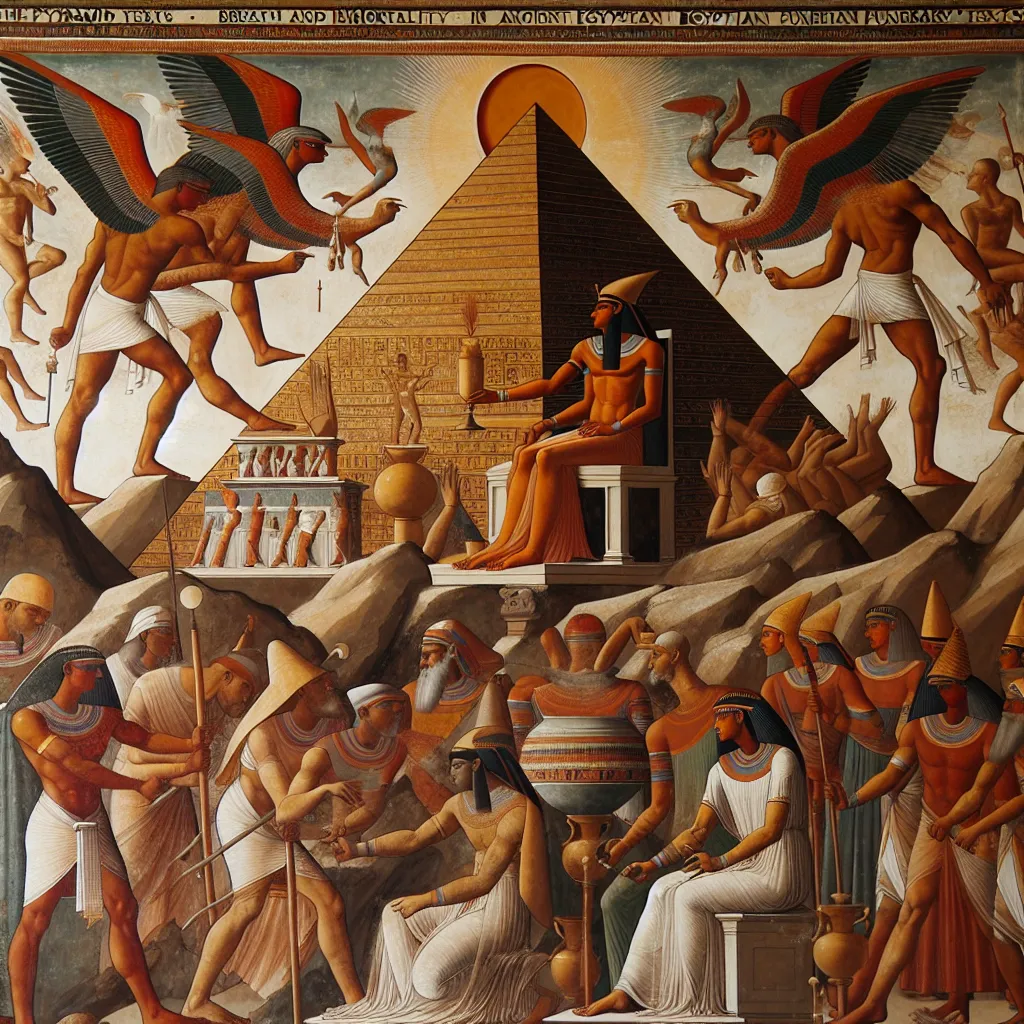
- Published on
- Authors

- Name
- You
The Pyramid Texts: Breath and Immortality in Ancient Egyptian Funerary Texts
The ancient Egyptian civilization has left us an indelible mark with its monumental architecture, enigmatic writings, and profound spiritual concepts. Among the most significant of their religious and funerary texts are the Pyramid Texts. These texts, inscribed on the walls of the pyramids primarily during the Old Kingdom, particularly focus on the theme of breath and its significance to immortality and the afterlife. This article will delve into the mystical wisdom and scientific insights surrounding the role of breath in the Pyramid Texts, providing a blend of historical exploration and esoteric understanding.
The Pyramid Texts: An Overview
The Pyramid Texts are arguably the oldest religious writings in the world, dating back to the Old Kingdom period (c. 2686–2181 BCE). These hieroglyphic inscriptions were carved into the walls of royal pyramids to assist the pharaohs in their journey to the afterlife. The texts encompass a variety of spells, prayers, and incantations designed to protect the deceased king and ensure his rebirth and eternal life.
Contents of the Pyramid Texts
| Category | Description |
|---|---|
| Hymns | Praising gods and kings, guaranteeing their roles in the cosmos. |
| Spells | Protecting the deceased from various perils in the afterlife. |
| Ritual Instructions | Providing specific guidance for ceremonies, including the Opening of the Mouth ritual. |
| Prayers | Invocations calling upon the gods for aid and sustenance in the afterlife. |
| Mythological Texts | Narratives explaining the cosmos, the roles of the gods, and the king's journey through the netherworld. |
Breath: The Vital Force
In many ancient cultures, the concept of breath was closely associated with life force and spiritual essence. The Egyptians were no different; they believed breath was a divine essence that connected mortal humans to the gods.
Breath and the Ba
In the Egyptian belief system, the soul consisted of several elements, one of which was the Ba—essentially, the living personality expressed as a bird with a human head. The Ba required breath to sustain its existence beyond death.
Excerpts from the Pyramid Texts:
"I have come to you, O my father Osiris, that I may breathe the air which is in your nostrils." - Utterance 325
These lines underscore the significance of breath in maintaining the life force, even in the afterlife.
Scientific Insights: The Role of Breath
Modern science tells us that oxygen is crucial for cellular respiration, which is essential for the production of ATP (adenosine triphosphate)—the energy currency of life. This parallels the ancient notion that breath (spirit) was central to sustaining life and maintaining consciousness.
Biological Insight Table:
| Biological Concept | Breath in Ancient Egypt | Modern Scientific Understanding |
|---|---|---|
| Life Force (Ka) | Ka required breath to sustain life | ATP production through cellular respiration |
| Sustenance of Soul | Ba needed access to breath to survive | Oxygen is essential for biochemical processes |
| Resuscitation | Breath as a revival tool | CPR and artificial ventilation techniques in medicine |
Immortality and the Afterlife
The Egyptians meticulously preserved the body and provided for the Ka and Ba, in the hopes of achieving immortality. Through the spiritual act of breathing air (or life force), the pharaoh was thought to be directly linked to the divine, ensuring his eternal existence.
Excerpts from the Pyramid Texts:
"Raise yourself, O King, receive this your bread which cannot grow moldy and this your beer which cannot turn sour." - Utterance 273
Mystical Interpretations
From a mystical perspective, breath is seen as a conduit for spiritual energy. Practices like pranayama in yoga also emphasize controlled breathing to harness and amplify spiritual lifeforce.
Comparative Table of Breath in Spiritual Practices:
| Practice | Culture | Concept of Breath |
|---|---|---|
| Pranayama | Vedic/Hindu | Prana (Life Force Energy) |
| Qi Gong | Taoist/Chinese | Qi (Vital Energy) |
| Tummo Breathing | Tibetan/Buddhist | Inner Fire or Energy |
| Breath of Life | Egyptian | Ba and Ka sustenance, divine link |
Conclusion
The Pyramid Texts provide a rich and intricate view of how the ancient Egyptians perceived breath as a fundamental aspect of life, death, and immortality. Coupled with modern insights into biology, we see a fascinating interplay between physical and spiritual realms. Whether viewed through the lens of advanced science or mystical wisdom, the role of breath in the Pyramid Texts reveals a timeless quest for eternal life and a deeper understanding of the human soul.
By exploring and embracing the wisdom enshrined in the Pyramid Texts, we can gain profound insights into the human condition, the mysteries of life and death, and the eternal quest for immortality that has captivated humanity for millennia.
